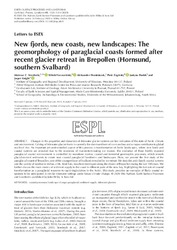New fjords, new coasts, new landscapes: The geomorphology of paraglacial coasts formed after recent glacier retreat in Brepollen (Hornsund, southern Svalbard)
Dominiczak, Aleksander
Dudek, Justyna
DOI: https://doi.org/10.1002/esp.4819
Persistent URL: http://resolver.sub.uni-goettingen.de/purl?gldocs-11858/9456
Persistent URL: http://resolver.sub.uni-goettingen.de/purl?gldocs-11858/9456
Strzelecki, Mateusz C.; Szczucinski, Witold; Dominiczak, Aleksander; Zagórski, Piotr; Dudek, Justyna; Knight, Jasper, 2020: New fjords, new coasts, new landscapes: The geomorphology of paraglacial coasts formed after recent glacier retreat in Brepollen (Hornsund, southern Svalbard). In: Earth Surface Processes and Landforms, Band 45, 5: 1325 - 1334, DOI: 10.1002/esp.4819.
 |
Dokument öffnen: |
Changes in the properties and dynamics of tidewater glacier systems are key indicators of the state of Arctic climate and environment. Calving of tidewater glacier fronts is currently the dominant form of ice mass loss and a major contributor to global sea-level rise. An important yet under-studied aspect of this process is transformation of Arctic landscapes, where new lands and coastal systems are revealed due to the recession of marine-terminating ice masses. The evolution of those freshly exposed paraglacial coastal environments is controlled by nearshore marine, coastal and terrestrial geomorphic processes, which rework glacial-derived sediments to create new coastal paraglacial landforms and landscapes. Here, we present the first study of the paraglacial coasts of Brepollen, one of the youngest bays of Svalbard revealed by ice retreat. We describe and classify coastal systems and the variety of landforms (deltas, cliffs, tidal flats, beaches) developed along the shores of Brepollen during the last 100 years. We further discuss the main modes of sediment supply to the coast in different parts of the new bay, highlighting the fast rate of coastal transformation as a paraglacial response to rapid deglaciation in the Arctic. This study provides an exemplar of likely coastal responses to be anticipated in similar tidewater settings under future climate change. © 2020 The Authors. Earth Surface Processes and Landforms published by John Wiley & Sons Ltd
Statistik:
ZugriffsstatistikSammlung:
- Geologie [931]
This is an open access article under the terms of the Creative Commons Attribution License, which permits use, distribution and reproduction in any medium, provided the original work is properly cited.

